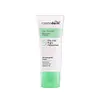What's inside
What's inside
 Key Ingredients
Key Ingredients

 Benefits
Benefits

 Concerns
Concerns

 Ingredients Side-by-side
Ingredients Side-by-side

Water
Skin ConditioningCyclopentasiloxane
EmollientEthylhexyl Stearate
EmollientPropylene Glycol
HumectantTalc
AbrasiveEthylhexyl Methoxycinnamate
UV AbsorberTitanium Dioxide
Cosmetic ColorantGlyceryl Stearate Se
EmulsifyingAluminum Starch Octenylsuccinate
AbsorbentIsopropyl Myristate
EmollientStearic Acid
CleansingCetearyl Alcohol
EmollientCeteareth-24
CleansingCetyl Alcohol
EmollientPolysorbate 20
EmulsifyingBenzophenone-3
UV AbsorberDimethicone
EmollientEthoxydiglycol
HumectantTocopheryl Acetate
AntioxidantCucumis Sativus Juice
EmollientGlycyrrhiza Glabra Root Extract
BleachingAloe Barbadensis Leaf Extract
EmollientPropanediol
SolventGlycerin
HumectantButylene Glycol
Humectant1,2-Hexanediol
Skin ConditioningMelaleuca Alternifolia Leaf Oil
AntioxidantTriethanolamine
BufferingMagnesium Aluminum Silicate
AbsorbentAlumina
AbrasiveSimethicone
EmollientXanthan Gum
EmulsifyingPhenoxyethanol
PreservativeSorbitan Caprylate
EmulsifyingWater, Cyclopentasiloxane, Ethylhexyl Stearate, Propylene Glycol, Talc, Ethylhexyl Methoxycinnamate, Titanium Dioxide, Glyceryl Stearate Se, Aluminum Starch Octenylsuccinate, Isopropyl Myristate, Stearic Acid, Cetearyl Alcohol, Ceteareth-24, Cetyl Alcohol, Polysorbate 20, Benzophenone-3, Dimethicone, Ethoxydiglycol, Tocopheryl Acetate, Cucumis Sativus Juice, Glycyrrhiza Glabra Root Extract, Aloe Barbadensis Leaf Extract, Propanediol, Glycerin, Butylene Glycol, 1,2-Hexanediol, Melaleuca Alternifolia Leaf Oil, Triethanolamine, Magnesium Aluminum Silicate, Alumina, Simethicone, Xanthan Gum, Phenoxyethanol, Sorbitan Caprylate
Ingredients Explained
These ingredients are found in both products.
Ingredients higher up in an ingredient list are typically present in a larger amount.
Cetyl Alcohol is a fatty alcohol. Fatty Alcohols are most often used as an emollient or to thicken a product.
Its main roles are:
Though it has "alcohol" in the name, it is not related to denatured alcohol or ethyl alcohol.
The FDA allows products labeled "alcohol-free" to have fatty alcohols.
Learn more about Cetyl AlcoholGlycerin is already naturally found in your skin. It helps moisturize and protect your skin.
A study from 2016 found glycerin to be more effective as a humectant than AHAs and hyaluronic acid.
As a humectant, it helps the skin stay hydrated by pulling moisture to your skin. The low molecular weight of glycerin allows it to pull moisture into the deeper layers of your skin.
Hydrated skin improves your skin barrier; Your skin barrier helps protect against irritants and bacteria.
Glycerin has also been found to have antimicrobial and antiviral properties. Due to these properties, glycerin is often used in wound and burn treatments.
In cosmetics, glycerin is usually derived from plants such as soybean or palm. However, it can also be sourced from animals, such as tallow or animal fat.
This ingredient is organic, colorless, odorless, and non-toxic.
Glycerin is the name for this ingredient in American English. British English uses Glycerol/Glycerine.
Learn more about GlycerinGlyceryl Stearate Se is a self-emulsifying (SE) form of glyceryl stearate. Self-emusifying means this ingredient automatically blends with water. It is an emulsifier, emollient, and cleansing agent.
As an emulsifier, Glyceryl Stearate Se prevents ingredients such as oil and water from separating. It is also a surfactant, meaning it helps cleanse the skin. Surfactants help gather oil, dirt, and other pollutants so they may be rinsed away easily.
Emollients help your skin stay smooth and soft. It does so by creating a film on top of the skin that helps trap moisture in.
Learn more about Glyceryl Stearate SeStearic Acid is a fatty acid. It is an emollient, emulsifier, and texture enhancer.
As an emollient, stearic acid helps soften skin. It aids the skin's protective barrier by preventing water loss. It also provides a gentle cleansing effect without stripping away natural oils.
Stearic acid may also be used to enhance the texture of products. It can add volume and stabilize ingredients such as water and oil. This can help water and oil ingredients from separating.
Sources of stearic acid include animal or vegetable fats/oils such as coconut or shea. It can be naturally found in butter, cocoa butter, shea butter, vegetable fats, and animal tallow.
This ingredient may not be Malassezia folliculitis, or fungal-acne safe.
Learn more about Stearic AcidWater. It's the most common cosmetic ingredient of all. You'll usually see it at the top of ingredient lists, meaning that it makes up the largest part of the product.
So why is it so popular? Water most often acts as a solvent - this means that it helps dissolve other ingredients into the formulation.
You'll also recognize water as that liquid we all need to stay alive. If you see this, drink a glass of water. Stay hydrated!
Learn more about Water